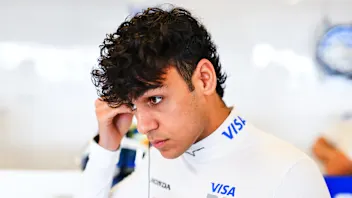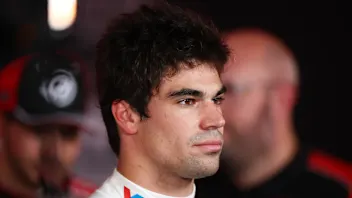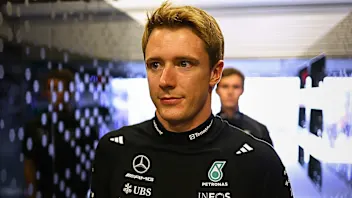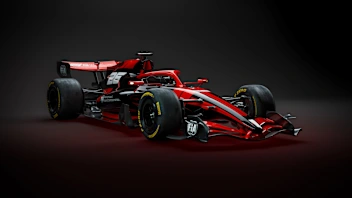Jolyon Palmer’s Analysis: Three tales of Peraltada

The Peraltada isn’t quite the exhilarating 180-degree, high-speed corner it once was, but in 2019 the reshaped Turns 16 and 17 caused some of the biggest talking points of the weekend…
Bottas gets it wrong
You approach Turn 16 at a low speed, but the exit is crucial, as Turn 17 is now comfortably flat out and leads you all the way down to Turn 1, one of the longest straights on the calendar.
In qualifying, although you only need to get to the start-finish line, rather than the whole slog down to the first corner, the exit speed is still critical, and with the top six drivers separated by less than half a second onto their final laps, this could make or break a qualifying lap.
For Valtteri Bottas he took that too literally. Too eager on the throttle and too wide on the exit, he ended up crashing hard into the barriers between Turn 16 and 17 of the old Peraltada.
It should be noted that the Mexican Grand Prix takes place at such high altitude - at 2,285 metres, it is higher than most ski resorts in the Alps. This means that the air is thinner and the cars therefore don’t generate the downforce they do at other circuits.
That means the drivers are fighting the car, with a loose rear end and also front locking common features of the Mexican GP weekend.
For Bottas it was the loose rear that caused his crash, but it all actually came from a bit of understeer through the corner, which forced him wide onto the exit kerb.
On the kerb there is simply less grip than the rubbered-in tarmac. The slightly raised profile and unevenness of the kerb also means you have less tyre in contact with the track and therefore less grip as well.
And throughout this, Bottas kept his right foot planted in his desire for that perfect exit and a shot at pole position.
Sure enough, he ended up having wheelspin as his rear tyres broke traction, and then because he was already right next to the wall on the exit, it took only this slight oversteer to pitch him hard into it, as he first caught the left rear which spat the car into the wall fully.
He rattled down the barrier and ultimately had quite a big impact at Turn 17 where a joining barrier jutted out. This would have been a nasty impact for Bottas and you could tell with his heavy breathing over the radio that he had had the wind knocked out of him.
READ MORE: Mercedes elated after Bottas recovers from qualifying crash to podium
It’s not the first Q3 traction error of 2019 for the Finn. Back in Canada, he also had a heavy right foot, ultimately combined with getting on the exit kerb, which sent him spinning. Luckily for him that time he kept it out of the barrier, but could only qualify seventh.
Max ignores the yellows
Bottas’s crash meant we had our second story of Peraltada within seconds. We shouldn’t have done, because Max Verstappen, already on provisional pole, should have backed off as all drivers are instructed to do so under yellow flags.
But he kept his foot in past the stricken Mercedes and improved on his pole position time for good measure.
READ MORE: Horner rues Mexican weekend that promised 'a lot more' for Verstappen
All drivers should know that you have to back off past yellow flags, as Sebastian Vettel did ahead of Bottas, foiling his own chance to improve. This has been ingrained in drivers for years now, and penalties have always been harsh and consistent.
For Verstappen, I can only imagine that he assumed someone had beaten his pole time, and that he thought he had to improve to keep pole. Either way it was foolish, as it was inevitable he would be penalised, and showed a level of immaturity, as did his comments afterwards.
In this situation the team, with all the information in front of them could have helped him out. Verstappen should have been told to back off before he even got to the Peraltada and that would have made his decision a lot simpler.
It doesn’t excuse his error, though. He should have known better and paid a three-place penalty price.
Kvyat proves too optimistic
The Peraltada wasn’t done until the chequered flag came out though, as the final moment saw Danil Kvyat pitch Nico Hulkenberg into the wall in a battle for ninth place.
This one was hopelessly optimistic from Kvyat, who was desperate to pass Hulkenberg. The German was struggling with his tyres at the end of the Grand Prix, having pitted on Lap 18 - five laps earlier than Hamilton who also did a long stint to the flag - and a full 26 laps earlier than Kvyat’s second stop.
That meant Hulkenberg was around a second a lap slower than the Toro Rosso in the closing stages, was scrabbling around for grip and that culminated in a big moment of oversteer through Turn 13, which put him off line and gave Kvyat a sniff of a pass into Turn 16.
Ultimately though for Kvyat, he wasn’t far enough alongside at any point and was not really committed enough for a pass. He was stuck in the horrible middle ground that meant he simply caught Hulkeberg’s right-rear and pitched him into the wall.
READ MORE: Kvyat handed post-race penalty, loses points after Hulkenberg clash
The stewards took all of four and a half minutes to decide a 10-second penalty would be correct for the Russian, arguing it was one of the most black and white cases they’ve seen, and it’s hard to disagree.
Next Up
Related Articles
 Marko ‘believed in me when others didn’t’ – Lindblad
Marko ‘believed in me when others didn’t’ – Lindblad Stroll opens up on 'noise' that has followed him in F1
Stroll opens up on 'noise' that has followed him in F1 ExclusiveVesti on life as Mercedes reserve and his F1 plan
ExclusiveVesti on life as Mercedes reserve and his F1 plan GALLERY: Check out renders of the innovative 2026 car
GALLERY: Check out renders of the innovative 2026 car Beyond The GridThe best of 2025, from Norris’ evolution to Brad Pitt’s ‘need for speed’
Beyond The GridThe best of 2025, from Norris’ evolution to Brad Pitt’s ‘need for speed’ F1 CEO Domenicali reflects on 'phenomenal' 2025
F1 CEO Domenicali reflects on 'phenomenal' 2025